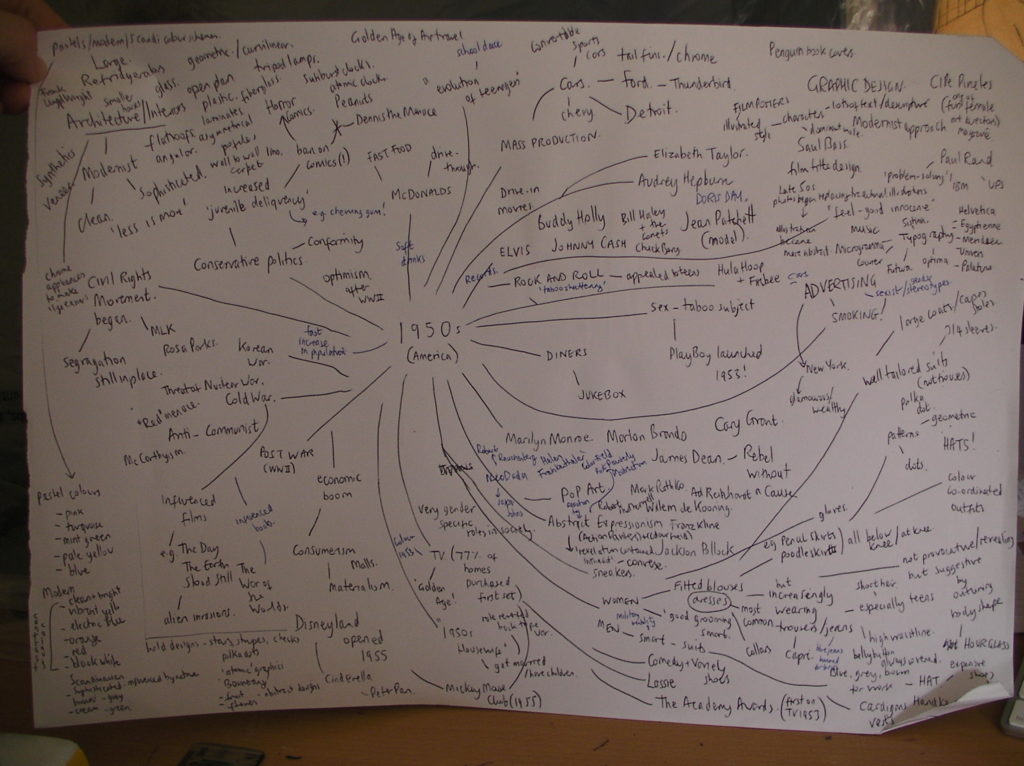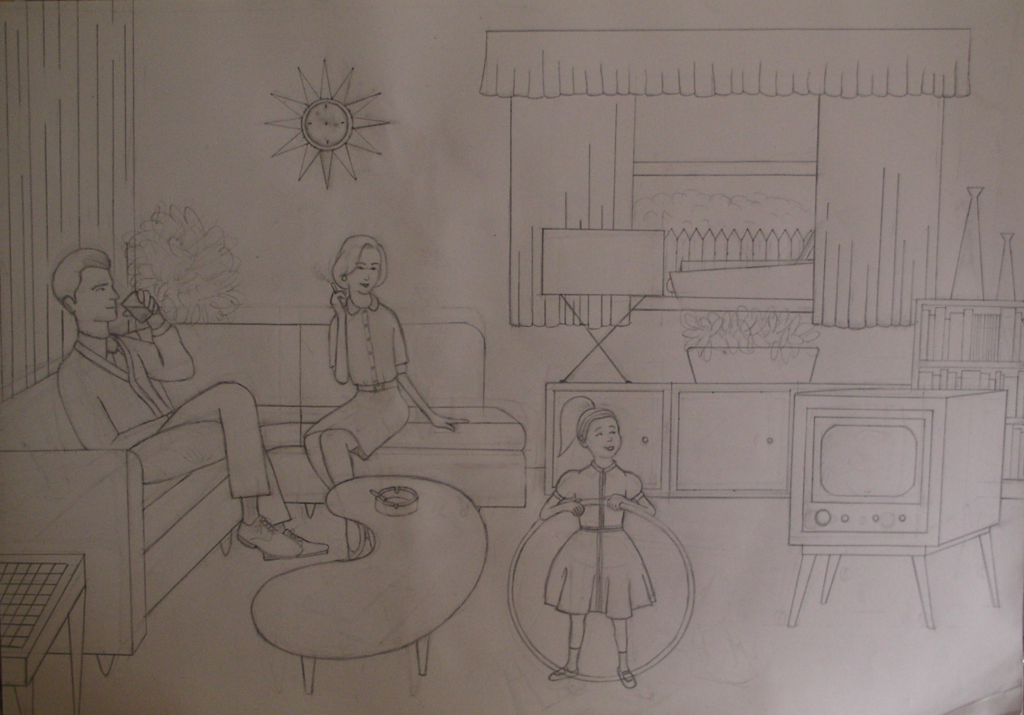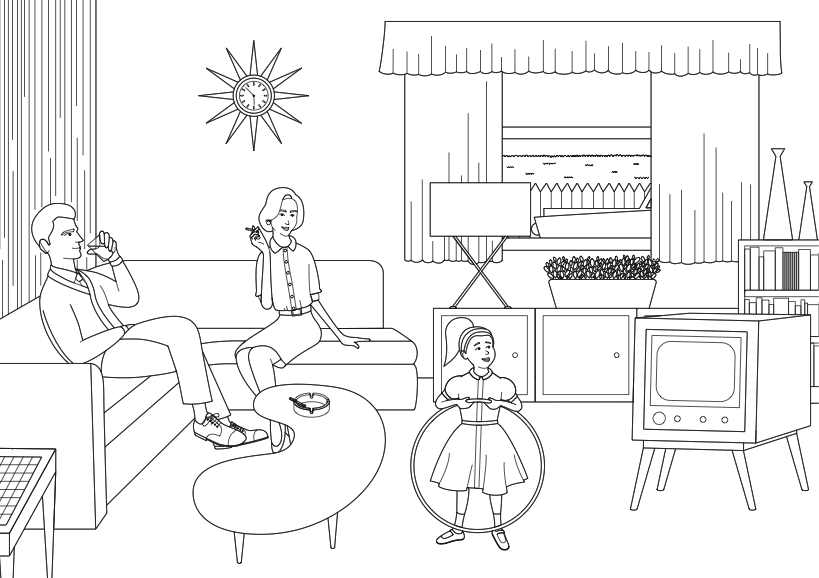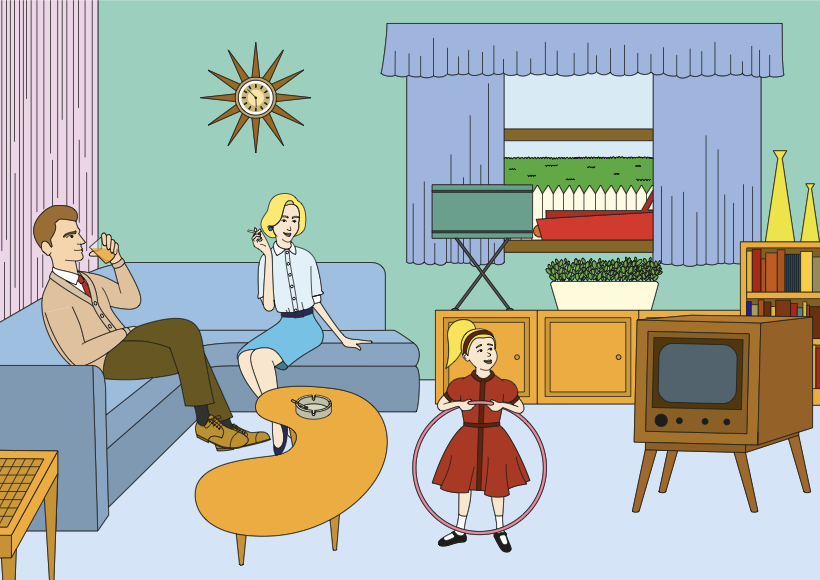Brief
Collect as much reference as you can find for the 1950s period. Catalogue the information you find according to these categories:
- People and costume
- Architecture and interiors
- Art – painting, drawing, sculpture
- Graphic design – posters, books, typography
- Advertising
- Transport
- Film and TV
- Surface pattern and decoration
Be eclectic in your sources. Identify the visual qualities that are universal within the categories – shapes, texture, colours, style and other features.
In your learning log write a short review of the 1950s from a visual perspective.
Describe the characteristics that typify the decade and the ideas and visual trends that were prevalent at this time.
Are there reflections of the 1950s in any areas of contemporary art, design or culture? If so, what – give examples. It may be useful to look both at what preceded and followed the 1950s to gain a sense of the broader context of this era.
Now make an illustration of someone sitting in a chair surrounded by typical artefacts to give a teenager an idea of the 1950s.
Mind-Mapping and Research
I decided to focus on the 1950s in in USA for this exercise. I started by creating a mind map of everything I could think of with regards to the 1950s. Once I had exhausted my own knowledge and ideas, I used further research to expand it.
For this exercise, I found mind-mapping really helpful and I kept adding to it as I progressed. I think this is the first time I have actually enjoyed creating a mind-map as I learnt so much about the topic.
Next I created separate folders for each category and then searched the internet for examples of each (I did not have access to any magazines, etc which would have had this type of content). I found quite a lot of informative websites, which both described and showed examples from the 1950s (these are listed at the end of this post).
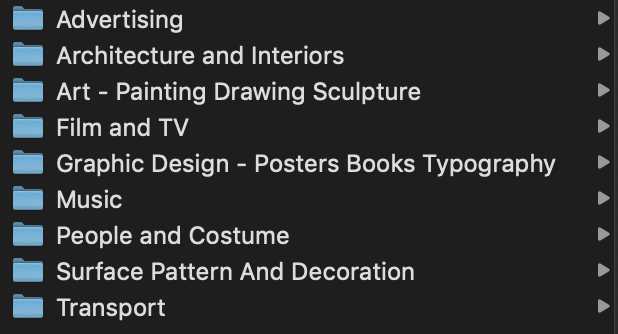
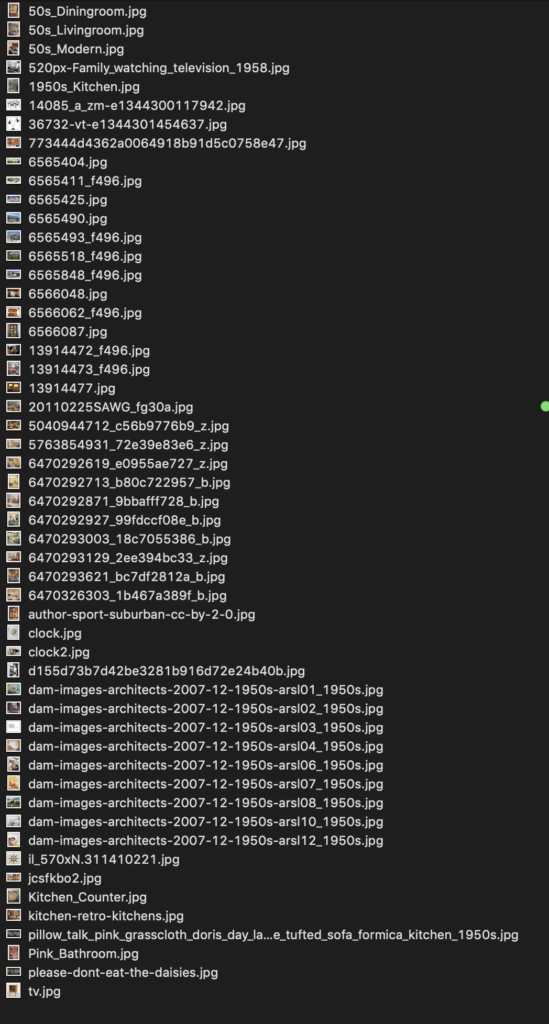
Review of 1950s from a visual perspective
The 1950s were a transition period from the end of the Second World War to a time of more optimism, consumerism and conservatism in the USA (and the Cold War).
Developments in manufacturing meant that mass production was now possible allowing the middle classes greater access to products, which in turn was encouraged by advertising and the culture of consumerism. Most households owned a TV in the 1950s, opening up another format for advertisers to entice consumers.
Plastic, vinyl and PVC were just some of the materials used for furniture design. The use of curved lines and futuristic designs along with bright, primary colours (and pastel colours) was very popular. Patterns were incorporated into furnishings, clothes and wallpaper, the ‘boomerang’ design being particular common. The ‘atomic clock was’ also popular in households.
The influence of the Cold War and the conservative government’s anti-communism rhetoric influenced many films and fiction from the 1950s, in which aliens/monsters (i.e. communists) invaded and attacked people. The start of space exploration also influenced media in the 1950s.
In terms of prominent art at that time, Abstract Expressionism was paramount, with artists such as Jackson Pollack and Mark Rothko at the forefront.
Although women had been ‘useful’ during the war in taking on the ‘roles of men’, but by the 1950s they were no longer required and returned to being dutiful housewives and mothers again. This message was reinforced by the stereotypical adverts from the period.
Although some women began wearing trousers in the 1950s, the overwhelming majority wore skirts and dresses, along with hats. Men generally wore suits, with hats, (or cardigans/vests at home) and were expected to look smart at all times.
The influence of design from the 1950s can be seen in the modern day, for example the popularity of retro appliances such as kettles, toasters and fridges.
The Illustration
I was originally going to make my illustration based in a 1950s kitchen, but then decided on a living room instead as I wanted to include certain elements, such as a TV. I began by doing some rough sketches, some of which are shown below.
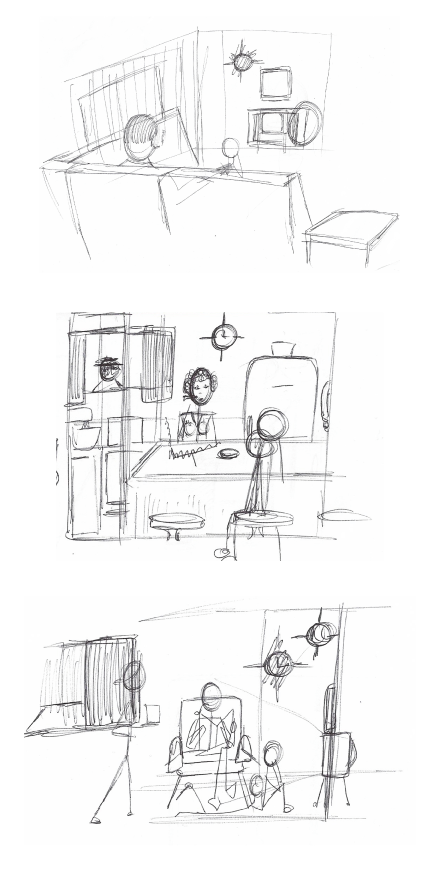
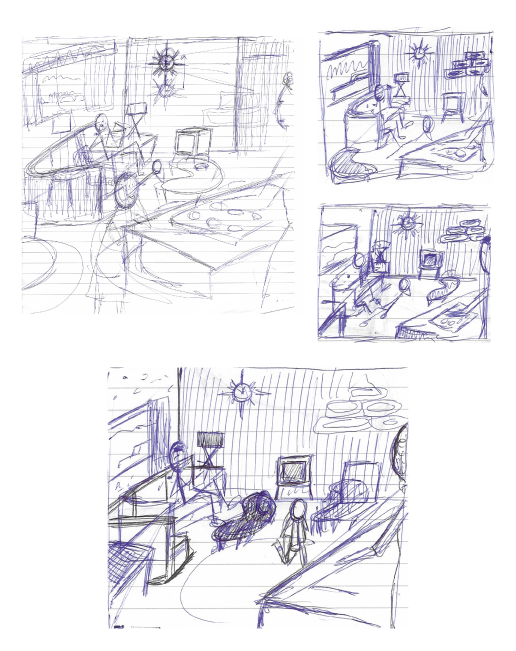
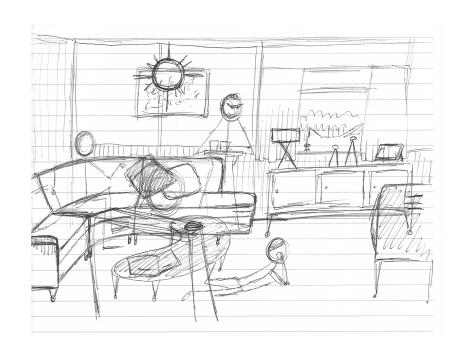
Although I was reasonably happy with the composition I had chosen to take forward (above), I spent a long, frustrating (!) amount of time reaching a final draft. I think I must have used an entire eraser trying to get it to look OK!
I scanned the pencil draft into Illustrator and worked on it further.
The final version of the illustration can be seen below in both outline and colour formats.
I really enjoyed this exercise and got quite carried away with it. I found the research very interesting and absorbing. I liked having to think what items I could include in the illustration to show it is set in the 1950s. The process of creating the illustration was (very!) frustrating, but in a way that challenged me and I learnt a great deal from doing it. I was most happy with the outline version as I feel I have a lot to learn in terms of colour choices and using colour to add depth to my work. I also realise there are issues with perspective and proportions, some of which I corrected as I progressed, but overall I was happy with the results.
References
Architectural Digest, (2007). 1950s Midcentury-Modern Design and Architecture. [online] Available at https://www.architecturaldigest.com/gallery/1950s-slideshow-122007 [Accessed 27 May 2020].
BBC Homes, (n.d.). 1950s. [online] Available at: http://www.bbc.co.uk/homes/design/period_1950s.shtml [Accessed 26 May 2020].
Bulovska, K. (2017). 1950s Home decor: Dynamic, vibrant designs influenced by science, space exploration & innovations in technology. [online] Available at: https://www.wallswithstories.com/interior/1950s-2.html [Accessed 26 May 2020].
Creative Bloq, (2013). 20 inspirational Penguin book cover designs. [online] Available at: https://www.creativebloq.com/graphic-design/penguin-covers-612338 [Accessed 26 May 2020].
Fifties Web, (n.d.). 1950s and 1960s Music, TV, History, Fashion, Slang, Cars. [online] Available at: https://fiftiesweb.com [Accessed 26 May 2020].
Hernandez, A. (2018). The Marvelous Mrs. Maisel’s Set Designer Shares the Secrets to Creating That Magical World. [online] Apartment Therapy. Available at: https://www.apartmenttherapy.com/marvelous-mrs-maisel-golden-globe-set-design-254069 [Accessed 27 May 2020].
House Beautiful, (2008). Kitchens of the 1950s. [online] Available at: https://www.housebeautiful.com/room-decorating/kitchens/g393/kitchens-1950s-0609/?slide=1 [Accessed 27 May 2020].
Illustration History, (n.d.). The Decade 1950-1960. [online] Norman Rockwell Museum. Available at: https://www.illustrationhistory.org/history/time-periods/the-decade-1950-1960 [Accessed 26 May 2020].
IndieWire, (n.d.). The 50 Best 1950’s Movie Posters. [online] Available at: https://www.indiewire.com/gallery/best-1950s-movie-posters/witness-for-the-prosecution-1957/ [Accessed 27 May 2020].
Laughead Jr., G. (2006). History: United States History Index: 1950-1959. [online] European University Institute. Available at: http://vlib.iue.it/history/USA/ERAS/20TH/1950s.html#1950 [Accessed 26 May 2020].
Llewellyn, M. (2020). The Golden Age of plane travel: what flying was like in the 1950s and 1960s compared to now. [online] Skyscanner. Available at: https://www.skyscanner.com.au/news/airlines/the-golden-age-of-plane-travel-what-flying-was-like-in-the-1950s-and-1960s-compared-to-now [Accessed 27 May 2020].
Planet Retro, (2010). 1950s Decorating Style. [online] Available at: https://blog.retroplanet.com/1950s-decorating-style/ [Accessed 27 May 2020].
Retrowaste, (n.d.). Cars in the 1950s. [online] Available at: https://www.retrowaste.com/1950s/cars-in-the-1950s/ [Accessed 26 May 2020].
Rhodes, M. (2015). Go Behind the Scenes of Mad Men’s Exquisite Set Design. [online] Wired. Available at: https://www.wired.com/2015/03/go-behind-scenes-mad-mens-exquisite-set-design/ [Accessed 26 May 2020].
Victoria and Albert Museum, (n.d.). Fashion Drawing and Illustration in the 20th Century. [online] Available at: http://www.vam.ac.uk/content/articles/f/fashion-drawing-in-the-20th-century/ [Accessed 27 May 2020].
Weber, H. (2012). Design Flashback: 10 Iconic typefaces born in the 1950’s. [online] The Next Web. Available at: https://thenextweb.com/news/design-flashback-10-iconic-typefaces-born-in-the-1950s [Accessed 27 May 2020].
Wikipedia, (n.d.). 1950s American automobile culture. [online] Available at: https://en.wikipedia.org/wiki/1950s_American_automobile_culture#Women’s_rights [Accessed 26 May 2020].
Wikipedia, (n.d.). 1950s Art Movements. [online] Available at: https://en.wikipedia.org/wiki/1950s#Art_movements [Accessed 26 May 2020].
Wikipedia, (n.d.). United States in the 1950s. [online] Available at: https://en.wikipedia.org/wiki/United_States_in_the_1950s [Accessed 20 May 2020].
